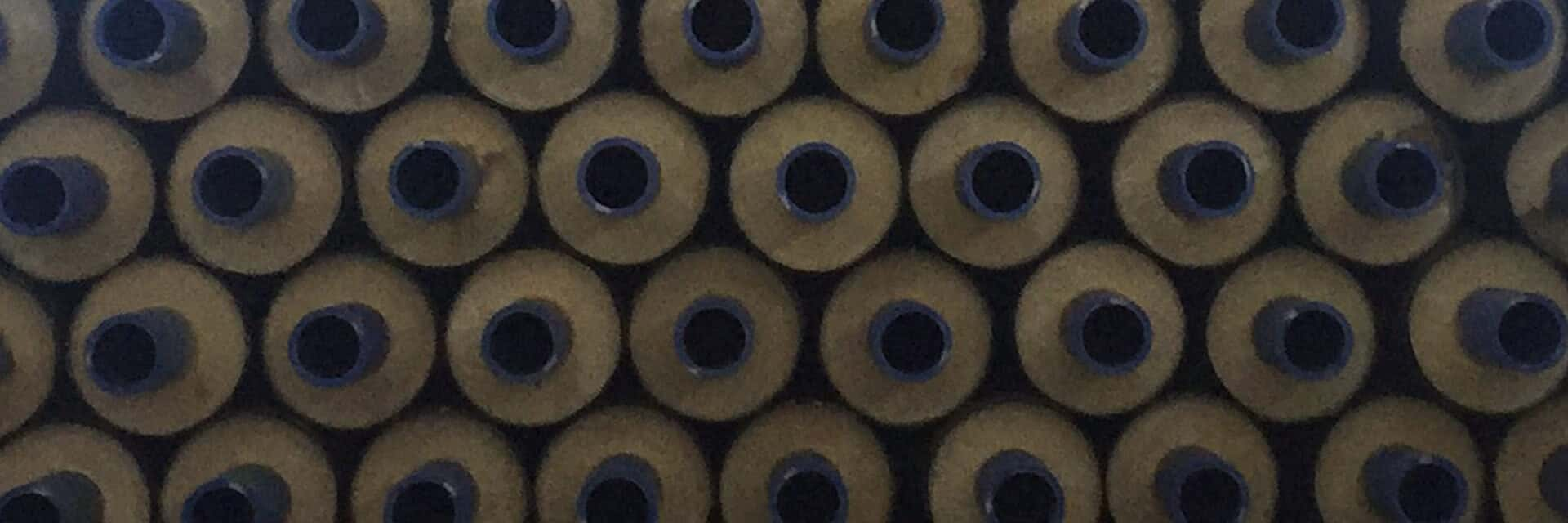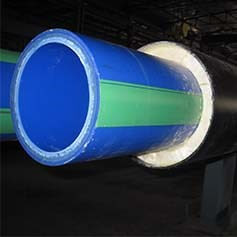
This type of pipe, composed of a special mixture of PPR raw material and glass fibre reinforced polypropylene in 3 or 5 layers, can be used at higher temperatures and pressures compared to normal PPR pipes. The elongation distances are much lower due to expansion. They are manufactured in accordance with the standards given in the table.
|
Production Standards |
|
TS 9937 |
|
TS EN ISO 15874-2 |
|
TS 11755-4 |
|
DIN 8077 |
|
DIN 8078 |
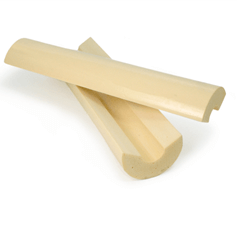
Rigid polyurethane foam is an insulation material with extremely low thermal transmission coefficient, consisting of mixing of polyol and isocyanate in certain ratios and pressure injection of these materials. PUR, which is injected between the carrier pipe and the casing pipe (HDPE), provides heat insulation as well as enabling two pipes operating as one pipe by bonding them together, and filling in the space between the pipes longitudinally. In the manufacturing of pre-insulated pipes, the PUR in accordance with the standard TS EN 253 has to meet the following minimum requirements:
Technical Specifications
|
Components |
Polyol and Isocyanate |
|
Minimum cellular mass density |
55 kg/m3 ISO 845 |
|
Max. Thermal Conductivity Coefficient |
0,029 W/mK ISO 8497 |
|
Average cell structure |
< 0,5 mm |
|
Closed cell content |
> %88 ISO 4590 |
|
Min. Radial Compressive Strength |
0,30 MPa ISO 844 |
|
Water absorption at high temperature |
< 10% when tested according to TS EN 253 5.3.5 |
|
Axial cutting strength |
23 °C ± 2 °C ≥ 0,12 N/mm² |
|
140 °C ± 2 °C ≥ 0,08 N/mm² |
|
|
Temperature range |
-50 °C / +148 °C |
|
Impact strength |
No damage must exist - when tested in accordance with EN 253 5.4.5 |
|
Linear Water Tightness |
Must be Watertight When tested in accordance with EN 253 5.4.6 |
|
Chlorofluorocarbon |
None |
|
Service life of insulation according to continuous service temperature |
3 years at 140 ˚C |
|
30 years at 120 ˚C |
|
|
50 years at 115 ˚C |
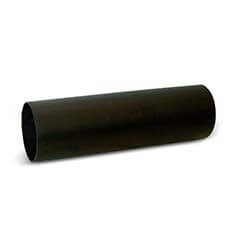
Extruded polyethylene casing pipe is used on the outermost part, which protects the insulation material from external factors and chemicals. The HDPE casing pipe manufactured in accordance with the standards TS EN 253 and TS EN 12201-2 must contain antioxidants, UV stabilisers and carbon black.
|
Standard |
EN 253, EN 12201-2 |
|
Dimensions |
EN 253 bölüm 4.3.2.2 table5 |
|
Material |
PE 80 – PE 100 ISO 9080 |
|
Density |
> 944 kg/m3 ISO 1133 |
|
Thermal Conductivity Coefficient |
0,43 W/mK |
|
Thermal Stability (OIT) |
> 20 min (210 °C) ISO 11357-6 |
|
Temperature Range |
40 °C / + 80 °C |
|
Cracking resistance under stress |
> 300 hrs (4 MPa, 80 °C) ISO 16770 |
|
Post-thermal treatment changes |
<%3 (no damage must exist) ISO 2505 |
|
Melt Flow Index (MFI 190°C/5kg) |
0,2 < MFR ≤ 1,0 g/10dk ISO 1133 |
|
Carbon black content |
> by mass % 2,5 ± 0,5 ISO 6964 |
|
Carbon black propagation degree |
<3 ISO 18553 |
|
Breaking elongation |
>% 350 ISO 6259-1 |
|
Hydrostatic Strength |
10,8 bar 80°C 165 sa ISO 1167-1-2 |
|
Inner surface treatment |
Corona process on extruded line (on-line) |
|
UV Protection |
Yes |
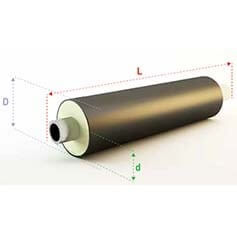
| PRODUCT NOMINAL SIZE | CET- PPR CARRIER PIPE**** | HDPE CASING PIPE | PUR | PIPE LENGTH | |||
| DN | Outer Diameter dₐ (mm) | Outer Diameter D (mm) | Wall Thickness s (mm) | Inner Diameter (mm) | Thickness (mm) | L (mt) | |
| Ø 20/75 | 20 | 20 | 75 | 3,0 | 69,0 | 24,5 | 4 - 6 |
| Ø 25/90 | 25 | 25 | 90 | 3,0 | 84,0 | 29,5 | 4 - 6 |
| Ø 32/90 | 32 | 32 | 90 | 3,0 | 84,0 | 26 | 4 - 6 |
| Ø 40/110 | 40 | 40 | 110 | 3,0 | 104,0 | 32 | 4 - 6 |
| Ø 50/110 | 50 | 50 | 110 | 3,0 | 104,0 | 27 | 4 - 6 |
| Ø 63/125 | 63 | 63 | 125 | 3,0 | 119,0 | 28 | 4 - 6 |
| Ø75/140 | 75 | 75 | 140 | 3,0 | 134,0 | 29,5 | 4 - 6 |
| Ø 90/160 | 90 | 90 | 160 | 3,0 | 154,0 | 32 | 6 - 12 |
| Ø 110/200 | 110 | 110 | 200 | 3,2 | 193,6 | 41,8 | 6 - 12 |
| Ø 125/225 | 125 | 125 | 225 | 3,4 | 218,2 | 46,6 | 6 - 12 |
| Ø 160/250 | 160 | 160 | 250 | 3,6 | 242,8 | 41,4 | 6 - 12 |
| Ø 200/280 | 200 | 200 | 280 | 3,9 | 272,2 | 36,1 | 6 - 12 |
| Ø 250/315 | 250 | 250 | 315 | 4,1 | 306,8 | 28,4 | 6 - 12 |
| Ø 315/400 | 315 | 315 | 400 | 4,8 | 390,4 | 37,7 | 6 - 12 |
| Ø 355/450 | 355 | 355 | 450 | 5,2 | 439,6 | 42,3 | 6 - 12 |
PRE-INSULATED GLASS FIBRE REINFORCED (COMPOSITE) GEOTHERMAL PPR PIPES
The structure of PPR-C pre-insulated pipes; The inner layers and outer layer parts consist of polypropylene (PP-R) material, glass fibre and polypropylene (PPR) raw material in the intermediate section. The inner surface of PPRC pipes is shiny and smooth. Besides, it has a slippery feature. There is no rusting and calcification in the pipe. Since PPRC pipes are hygienic, they can be used safely in the liquid they carry. Installation and installation of pre-insulated composite plastic pipes is much easier in the face of the difficulty of installation of metal pipes.
PPRC pipes without bacteria production have completely hygienic properties. Again, PPRC pipes are pipes with high resistance to heat, bad chemical effects and pressure. They do not add colour, taste and odour to the fluids carried inside and especially to drinking water. Expansion coefficient is very low. It is possible to use at -20 °C -80 °C temperature values in the transport of fluids with corrosive properties. PPRC pipes continue to operate for up to 50 years in accordance with the instructions for use and manufacturer's recommendations.
PPRC pipes are manufactured from raw materials that can withstand pressure amounts of PPR 100 and above.
Special production colours are also possible and they are generally manufactured in white, green and grey colours.
PPRC pipe consists of 3 layers as polypropylene in the inner layer, polypropylene in the outer layer and polypropylene raw material with micron diameter and very short glass fibre additive in between. Thanks to the glass fibre in the middle layer, the pressure performance of the pipe increases while the thermal expansion decreases.
The coefficient of thermal expansion (elongation), also called thermal expansion, is 0.040mm / mK.
If it is produced with the right methods, its impact resistance is better than other pipes.
It is both a quality and economical material when looking at competing pipes.
With these features, pre-insulated composite pipes can be used safely in hot water distribution networks, central and local heating networks, high pressure system applications for years.
WHAT ARE THE ADVANTAGES OF PP-R COMPOSITE PIPES?
- The performance of this type of pipe is very high.
- It can withstand high pressures.
- It can be simply welded with the help of standard welding machines without the shaving process available in other pipe systems.
- When hot water passes through the inside of PP-R geothermal composite pipes, there is no sagging in the pipe. Thermal elongation coefficient is low.
- PP-R pipes are highly resistant to breakage and impacts. Breakage and cracking are less common in cold weather compared to hot weather.
- The glass fibre support in the middle part of the pipe structure does not harm human health.
- When looking at other pipe systems, heat loss is less in composite pipes. They retain heat, so there is no heat transfer.
- Pre-insulated glass fiber-protected plastic pipes are produced to withstand high temperatures. Thanks to this feature, it is preferred in boiler installations and heating systems.
- Moss, sediment and bacteria do not occur in the pre-insulated plastic pipe structure.
WHAT ARE THE DIFFERENCES BETWEEN PPR PIPE AND PVC PIPE?
Continuously evolving economic systems and social development have led to the development of the construction sector, municipality, water technology, agricultural industry and other industries. Both PPR pipe and PVC pipe are frequently used in developing industries. The differences between PVC pipe and PPR pipe are generally as follows:
- There are material differences. Geothermal PVC pipe is made of polyvinyl chloride, while Geothermal PPR pipe is made of random copolymer polypropylene.
- There are colour differences between the two pipes. PPR pipe colour is tougher, brighter and better than PVC pipe. Other colours of PPR pipe are light yellow and lower quality colour. The mixing quality of this pipe colour is high. Only the surface of the outer wall of PVC pipe is bright. PVC pipe is milky white in colour. The hardness of the material is higher than PPR pipes.
- There is also a difference in wall thickness between PVC and PPR. The biggest difference in PPR and PVC pipes with the same diameter is the difference in wall thickness. PVC pipe has less wall thickness than PPR pipe.
- Price differences are available. In general, the price of PVC pipes is lower than PPR pipes. Therefore, PVC pipes are advantageous in terms of price.
- PPR pipes are light and resistant to corrosion. The service life of PPR pipes, which are hygienic, is quite long. With its non-toxic feature, PPR pipes can be used safely in drinking water transport, cold and hot pipelines. PPR pipes can operate up to a maximum temperature of 90 degrees, 70 work. The service life is close to 50 years. The service life of PPR pipes at room temperature is more than 100 years. It is easy and convenient to install and assemble. PPR pipe is a material with high both hot and cold welding performance. PPR pipe is a material that can be recycled. It can also be used 2 times in production.
PVC pipe is a heavier material than PPR pipe. Its resistance to corrosion is higher than PPR pipe. It is less resistant to high temperatures. It is ideal for cold water transportation. Service life can be up to 70 years within the scope of cold water transportation works. PVC pipes can be recycled. Pipe waste can be reused during the production phase.

